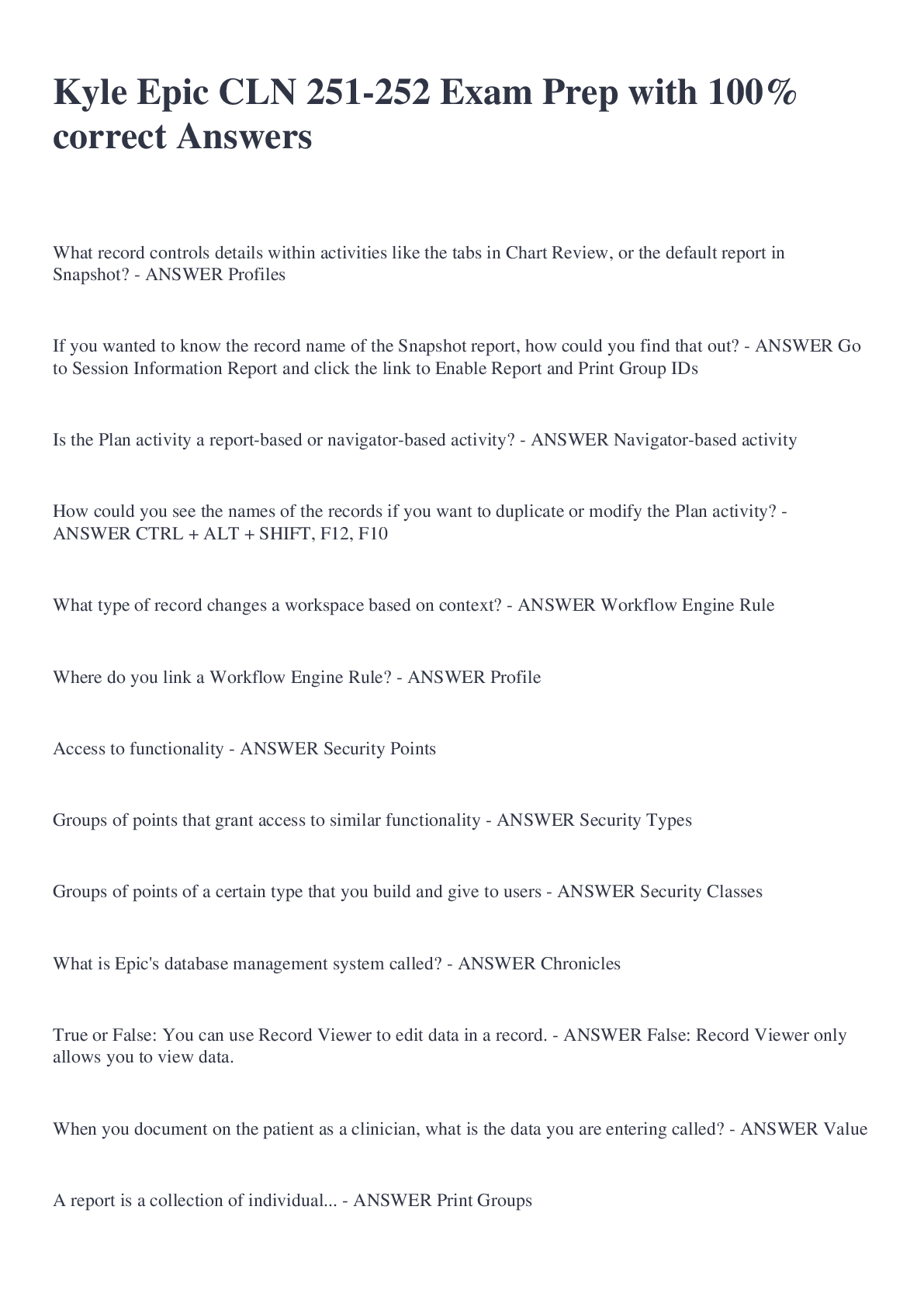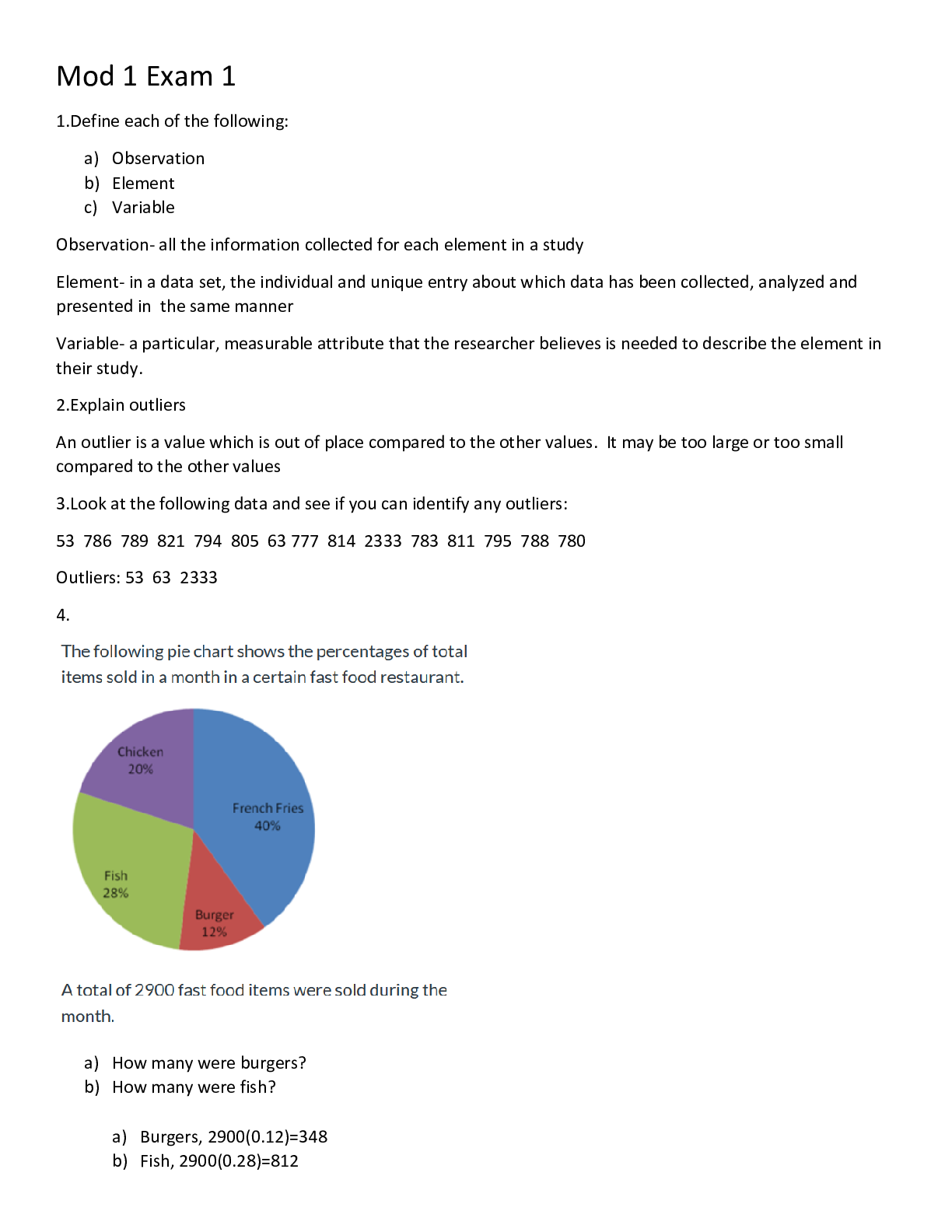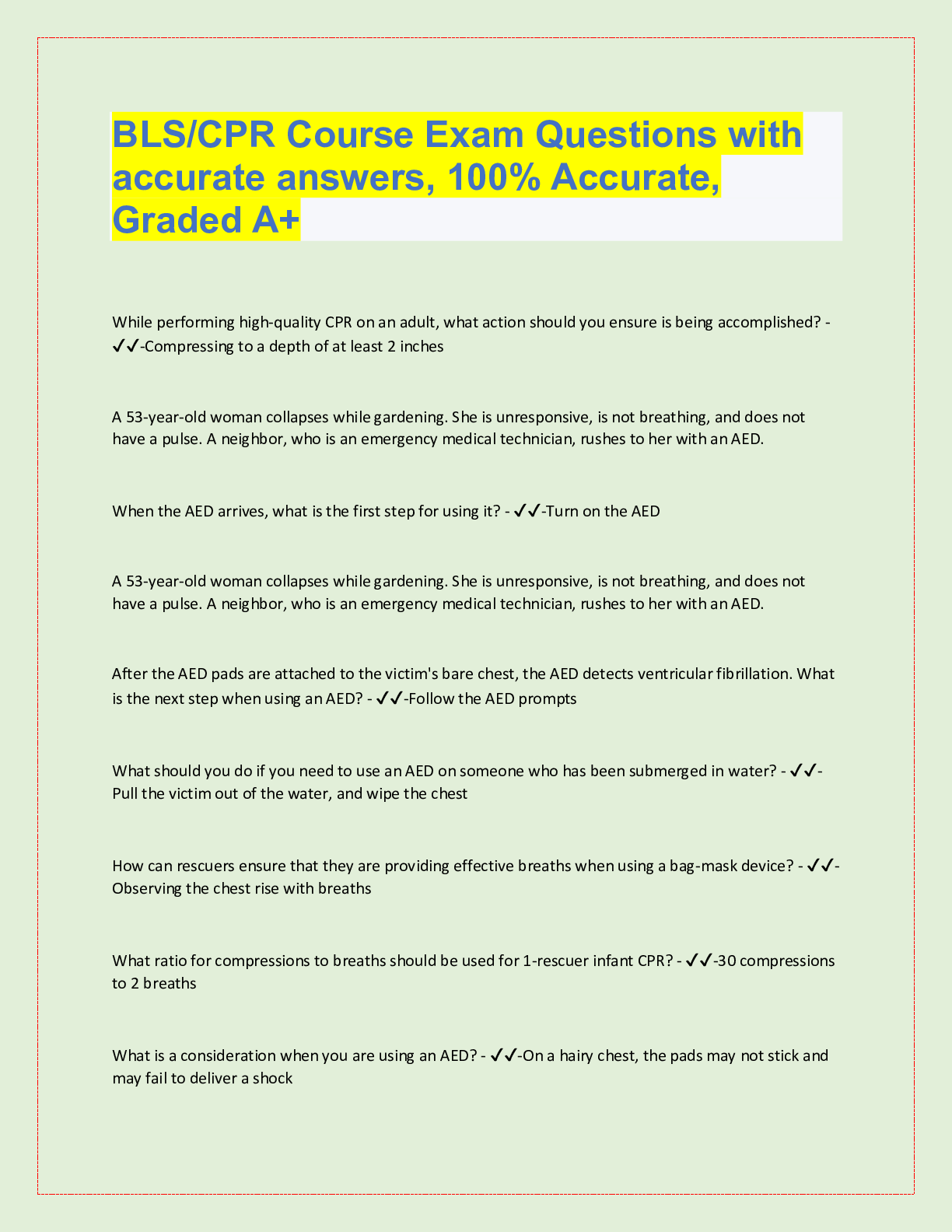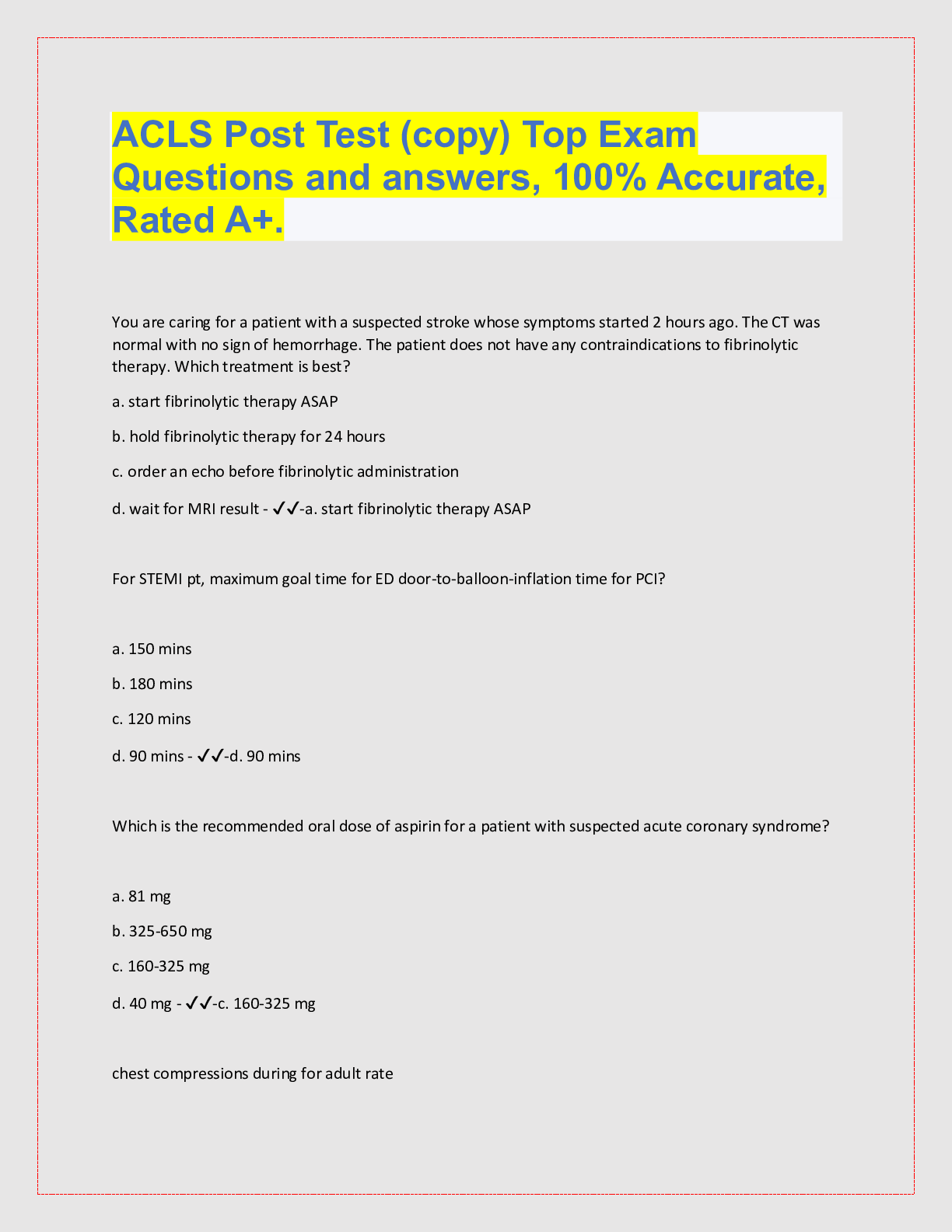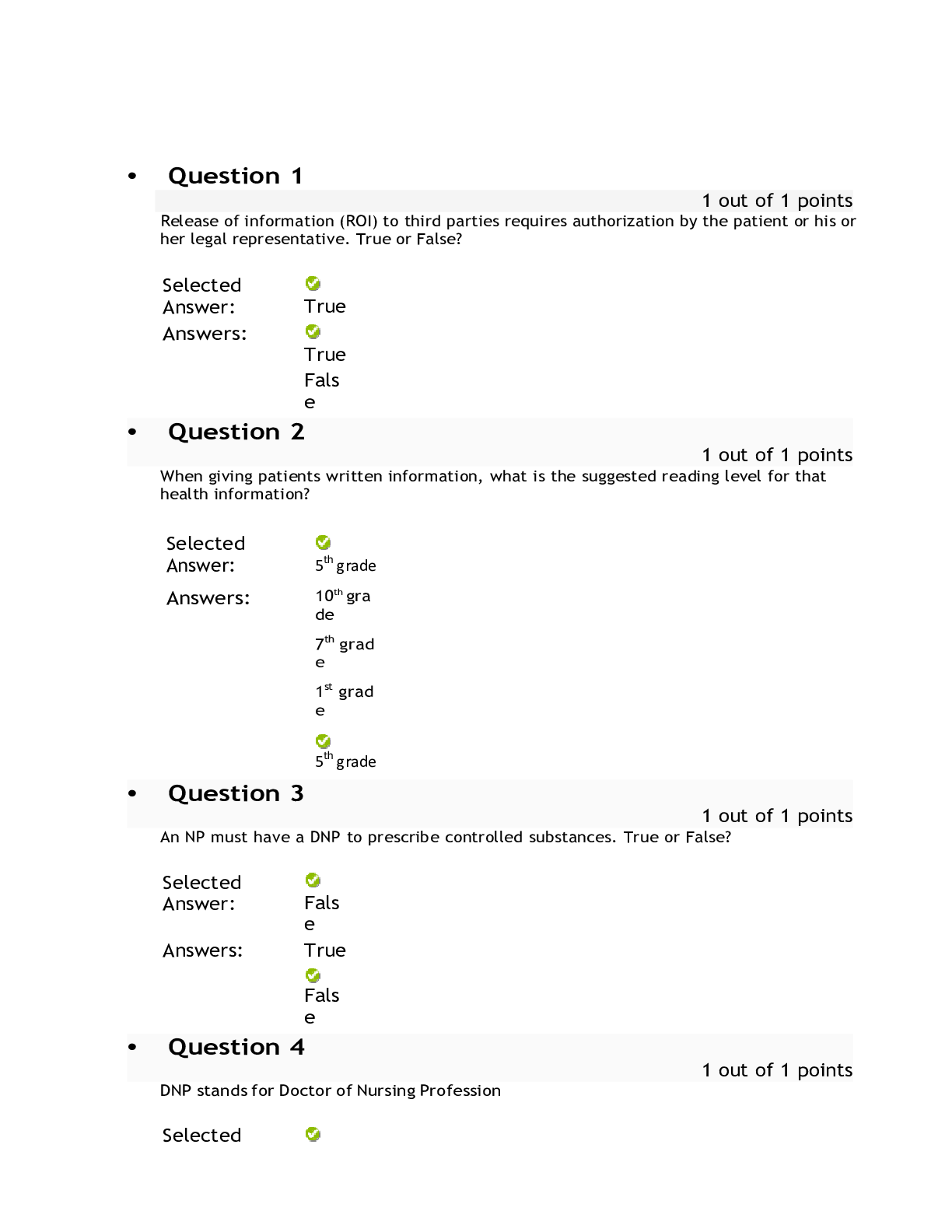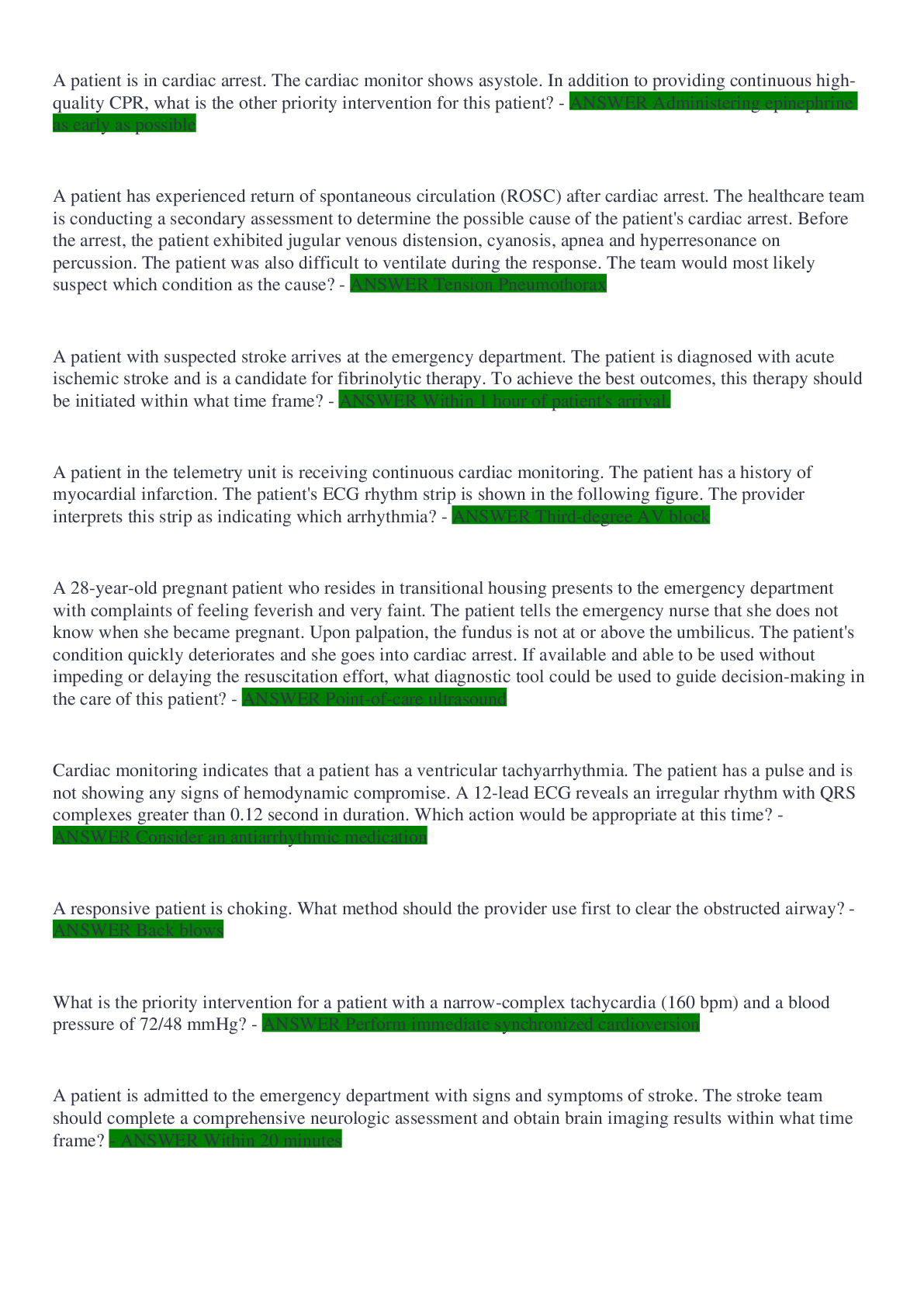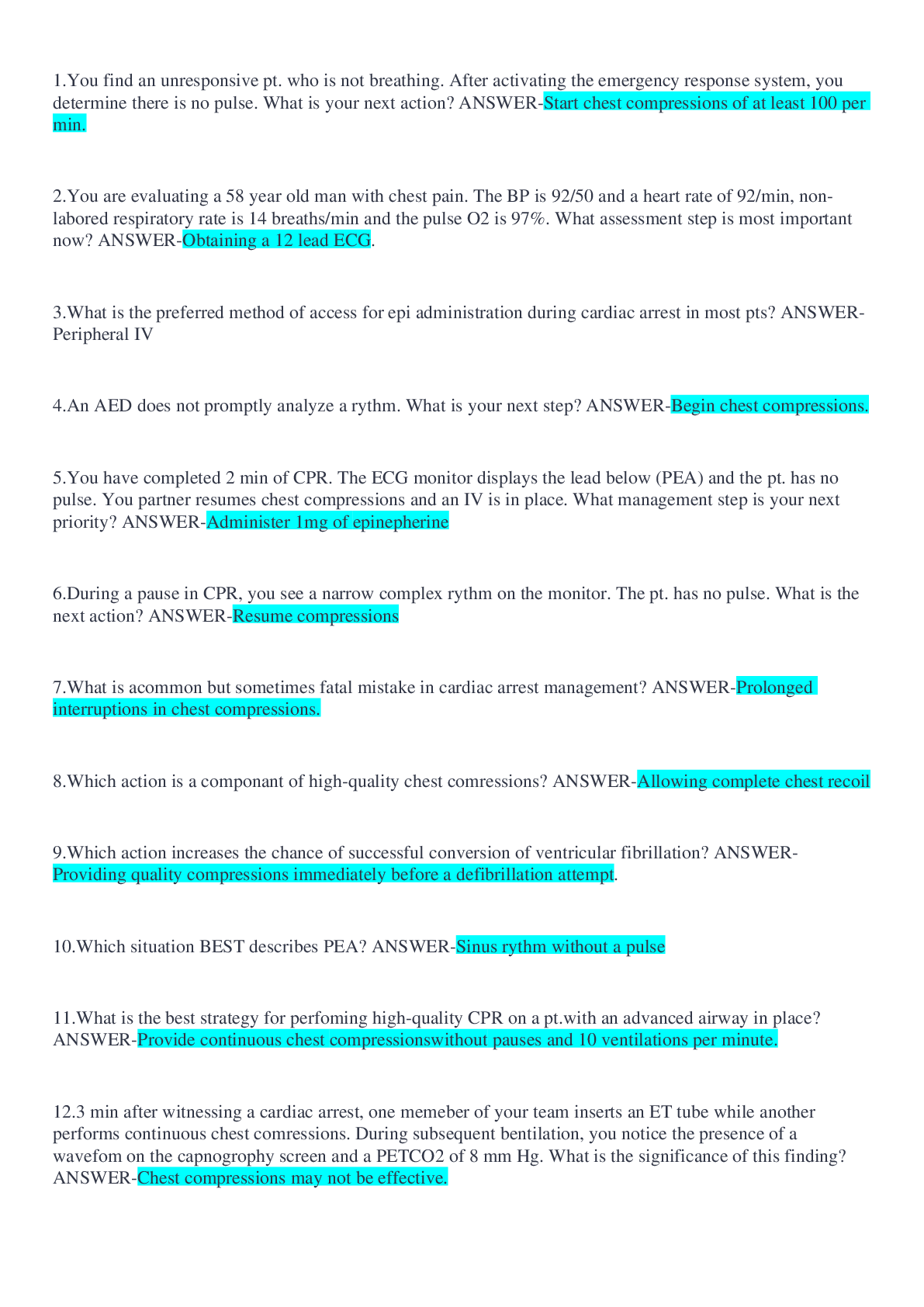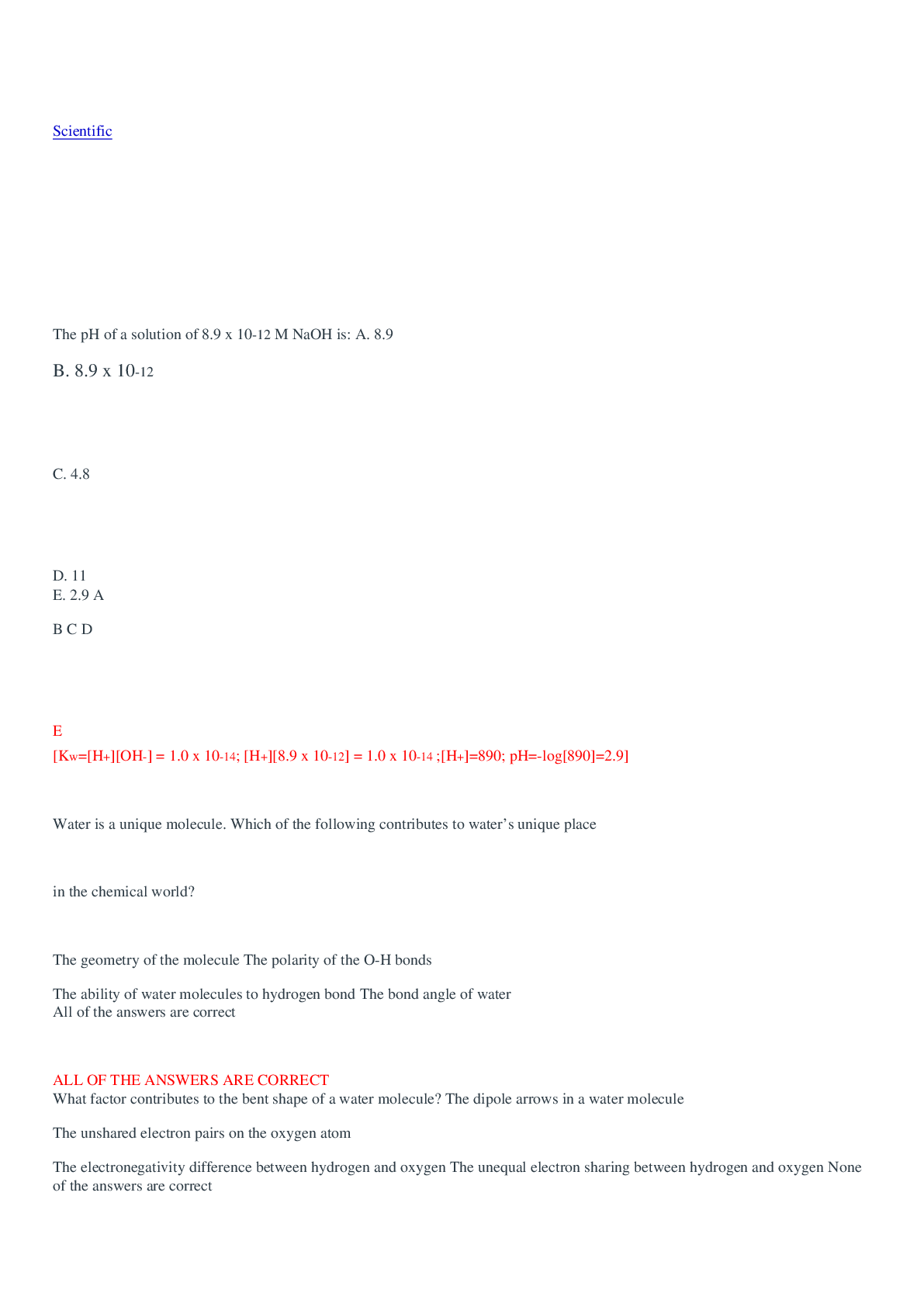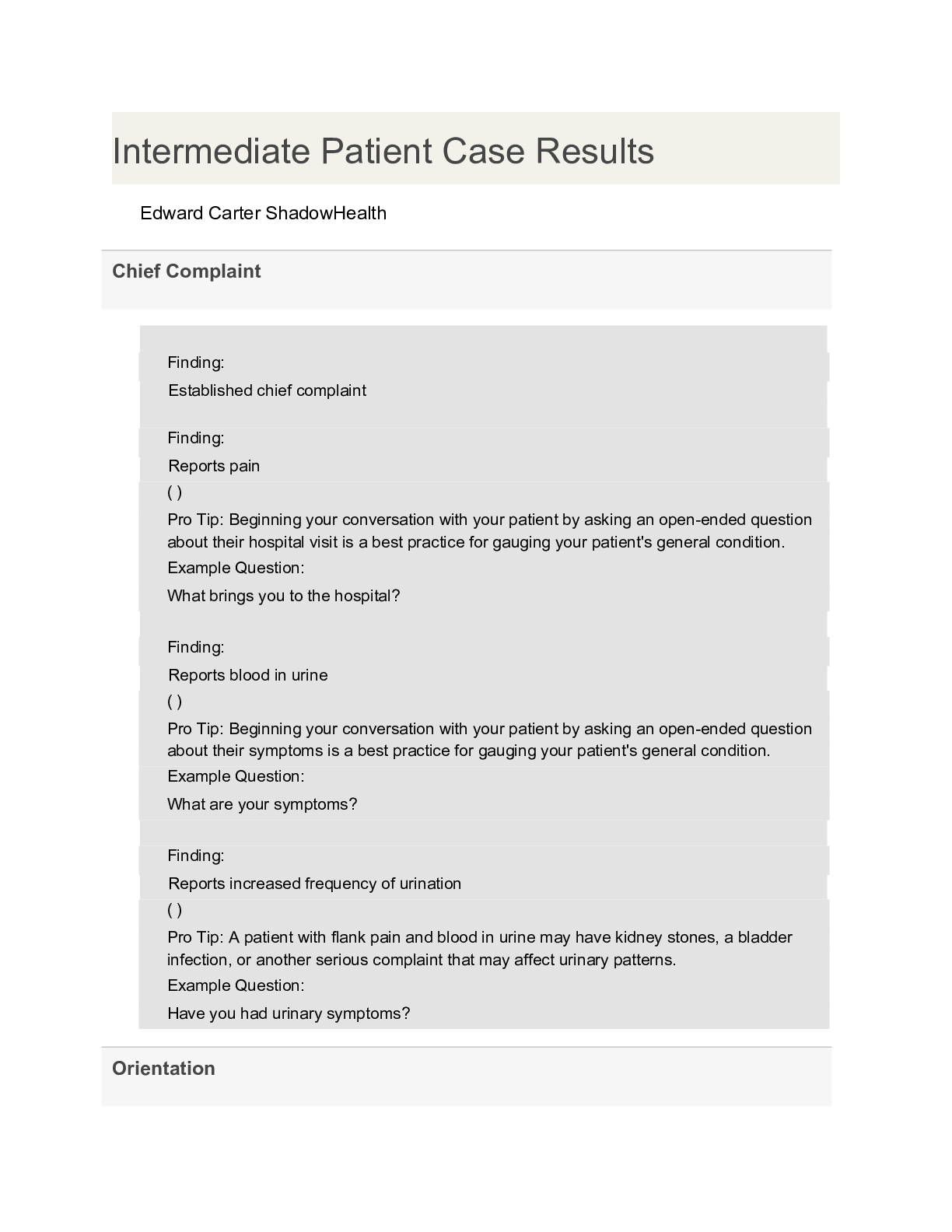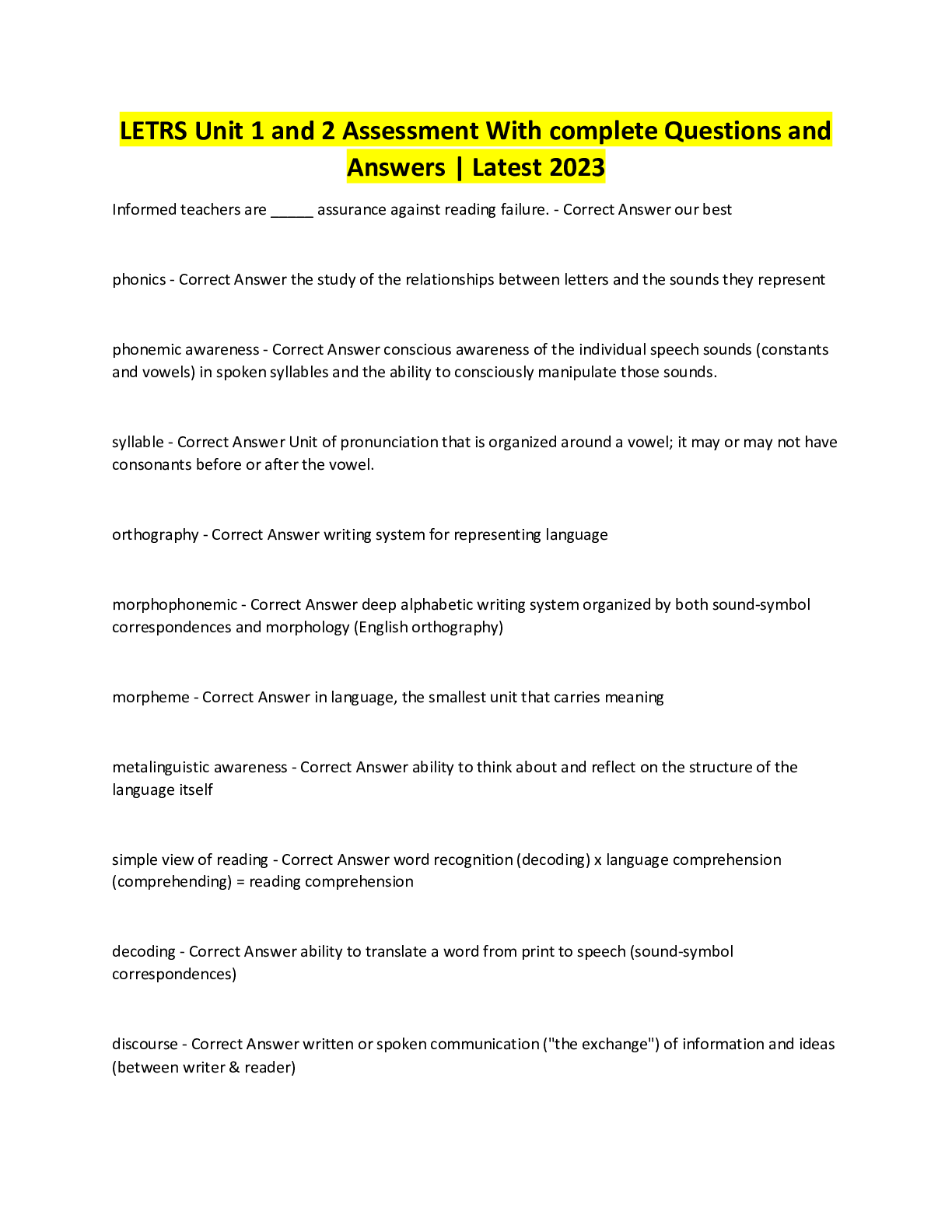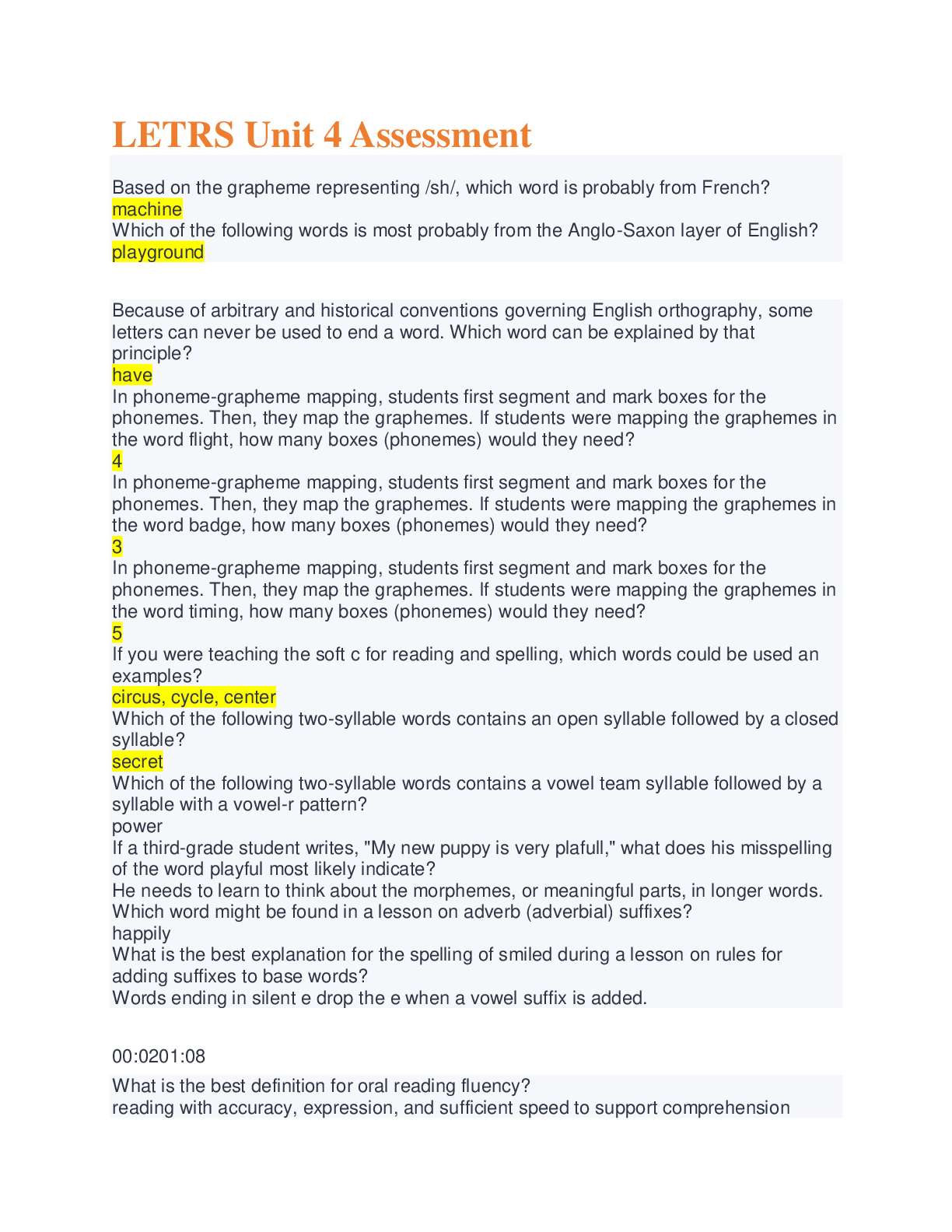NR 222 Exam #1 Chamberlain Questions and Answers
Document Content and Description Below
CHAPTER 1 - ANSWER Nursing Today Benner's Model of Novice to Expert - ANSWER Novice Advanced beginner Competent Proficient Expert ANA definition of nursing - ANSWER the protection, promotion... , and optimization of health and abilities, prevention of illness and injury, alleviation of suffering through the diagnosis and treatment of human response, and advocacy in the care of individuals, families, communities, and populations ANA Standards of Nursing Practice - ANSWER Assessment Diagnosis Outcomes Identification Planning Implementation Coordination of Care Health Teaching + Health Promotion Consultation Prescriptive Authority + Treatment Evaluation ANA Standards of Professional Performance - ANSWER Ethics Education Evidence-Based Practice Quality of Practice Communication Leadership Collaboration Professional Practice Resources Environmental Health Autonomy - ANSWER Essential element of professional nursing that involves the initiation of independent nursing interventions without medical orders. Advanced Practice Registered Nurse (APRN) - ANSWER Most independently functioning nurse; has masters degree in nursing Clinical Nurse Specialist (CNS) - ANSWER An APRN who is an expert clinician in a specialized area of practice Nurse Practioner (NP) - ANSWER Are prepared to provide direct client care in primary care settings, focusing on health promotion, illness prevention, early diagnosis, and treatment of common health problems Certified Nurse-Midwife (CNM) - ANSWER An APRN who is also educated in midwifery and is certified by the American College of Nurse-Midwifes Certified Registered Nurse Anesthetist (CRNA) - ANSWER An APRN with advanced education in a nurse anesthetia accredited program Nurse Educator - ANSWER works primarily in schools of nursing, staff development departments of health care agencies, and patient education departments Nurse Administrator - ANSWER manages patient care and the delivery of specific nursing services within a health care agency Nurse Researcher - ANSWER conducts evidence-based practice and research to improve nursing care and further define and expand the scope of nursing practice Florence Nightingale - ANSWER Founder of modern nursing; started first organized program to train nurses; first practicing nurse epidemiologist; connected sanitation with cholera and dysentery Clara Barton - ANSWER Nurse during the Civil War; founder of the American Red Cross Mary Mahoney - ANSWER First professionally trained African American nurse Mary Adelaide Nutting - ANSWER First professor of nursing at Columbia University Teachers College in 1906. Compassion fatigue - ANSWER described as physical, emotional, and spiritual exhaustion resulting from seeing patients suffer, leads to a decreased capacity to show compassion or empathize with suffering people Burnout - ANSWER Occurs when perceived demands outweigh perceived resources Lateral violence - ANSWER Aggressive and destructive behavior or psychological harassment of nurses against each other Genomics - ANSWER Study of whole genomes, including genes and their functions CHAPTER 2 - ANSWER Health Care Delivery System Health Services Pyramid - ANSWER Managing health instead of illness Emphasis on wellness Injury prevention programs Primary Health Care - ANSWER Focuses on improved health outcomes for an entire population; includes primary care and health education, proper nutrition, maternal/child health care, family planning, vaccines, and control of diseases Intensive Care - ANSWER Patients receive close monitoring and intensive medical care Psychiatric Facilities - ANSWER Patients who suffer emotional and behavioral problems such as depression, violent behavior, and eating disorders often require special counseling and treatment in psychiatric facilities Rural Hospitals - ANSWER Located in a county that has a low population density Restorative Care - ANSWER Care that helps persons regain their health, strength, and independence Home Care - ANSWER Provision of medically related professional and paraprofessional services and equipment to patients and families in their homes for health maintenance, education, illness prevention, diagnosis and treatment of disease, palliation, and rehabilitation Rehabilitation - ANSWER Restores a person to the fullest physical, mental, social, vocational, and economic potential possible Extended Care Facility - ANSWER A facility that provides health care and help with the activities of daily living to people who may be physically or mentally unable to care for themselves; this type of care may last from days to years Skilled Nursing Facility (SNF) - ANSWER Includes administration of IV fluids, wound care, long term ventilator management, and rehab Continuing Care - ANSWER For people who are disabled, functionally dependent, or suffering a terminal disease Assisted Living - ANSWER A living arrangement for elderly people that combines privacy and independence with medical supervision Respite Care - ANSWER A type of care provided for caregivers of homebound ill, disabled, or elderly patients; gives the normal care-takers time off Adult Day Care - ANSWER A program for impaired adults that attempts to meet their health, social, and functional needs in a setting away from their homes Hospice - ANSWER Allows patient to live with comfort, independence, and dignity while easing the pains of terminal illness IOM Competencies - ANSWER Patient Centered Care Work in Interdisciplinary Teams Use Evidence-Based Practice Apply Quality Improvement Use Informatics Ten Rules of Performance in a Redesigned Health Care System - ANSWER 1. Care is based on continuous healing relationships 2. Care is individualized based on patient needs and values 3. Patient is the source of control, participates in decision-making 4. Knowledge is shared, info flows freely 5. Decision making is evidence-based 6. Safety is a system property and focused on reducing errors 7. Transparency is necessary through sharing info with patients and families 8. Patients needs are anticipated 9. Waste is continuously decreased 10. Cooperation and communication among clinicians are priorities Quality Health Care - ANSWER The degree to which health services for individuals and populations increase the likelihood of desired health outcomes and are consistent with current professional knowledge Pay for performance programs - ANSWER Designed to promote quality, effective, and safe patient care by physicians and health care organizations Quality improvement strategies that reward excellence through financial incentives to motivate change to achieve measurable improvements Six Sigma - ANSWER A data-driven approach for improving quality by removing defects and variations in processes Patient-Centered Care - ANSWER Recognize the patient or designee as the source of control and full partner in providing compassionate and coordinated care based on respect for patient's preferences, values, and needs Magnet Recognition Program - ANSWER Recognition by the American Nurses Credentialing Center that an organization provides quality nursing care Nursing-sensitive outcomes - ANSWER Patient outcomes and nursing workforce characteristics that are directly related to nursing care such as changes in patients' symptom experiences, functional status, safety, psychological distress, registered nurse job satisfaction, total nursing hours per patient day, and costs Nursing Quality Indicators - ANSWER Outcomes of nursing care, identified by the American Nurses Association, that address patient safety and quality of care Nursing informatics - ANSWER Uses information and technology to communicate, manage knowledge, mitigate error, and support decision making Telemedicine - ANSWER Involves the use of video, audio, and computer systems to provide medical and/or health care services Vulnerable populations - ANSWER Collection of individuals who are more likely to develop health problems as a result of excess risks, limits in access to health care services, or being dependent on others for care CHAPTER 6 - ANSWER Health and Wellness Healthy People 2020 - ANSWER A set of disease prevention and health promotion objectives for Americans to meet during the second decade of the new millennium Health - ANSWER A state of complete physical, mental, and social well-being, not merely the absence of disease or infirmity. Health beliefs - ANSWER A person's ideas, convictions, and attitudes about health and illness Positive health behaviors - ANSWER Activities related to maintaining, attaining, or regaining good health and preventing illness Negative health behaviors - ANSWER Inculde practices actually or potentially harmful to health such as smoking, drug or alcohol abuse, poor diet and refusal to take necessary medications Health Belief Model - ANSWER Addresses the relationship between a person's beliefs and behaviors Health Promotion Model - ANSWER Directed at increasing a patient's level of well-being Maslow's Hierarchy of Needs - ANSWER Physiological Safety Love + Belonging Self Esteem Self-actualization Holistic Health Model - ANSWER Attempts to create conditions that promote optimal health Internal Variables that Influence Health - ANSWER Developmental stage, intellectual background, perception of functioning, emotional factors, spiritual factors External Variables that Influence Health - ANSWER Family practices, socioeconomic factors, cultural background Health promotion - ANSWER The process of enabling people to increase control over, and to improve, their health Illness Prevention - ANSWER Health education programs or activities directed toward protecting patients from threats or potential threats to health and minimizing risk factors Passive Health Promotion Strategies - ANSWER Ex. Fluoride in water, fortified foods Active Health Promotion Strategies - ANSWER Ex. weight reduction, smoking-cessation Levels of Preventive Care - ANSWER Primary, secondary, tertiary Primary Prevention - ANSWER True prevention, precedes disease or disfunction and applied to patients considered physically and emotionally healthy Includes: health education, vaccines, nutritional programs, fitness activities Secondary Prevention - ANSWER Focuses on individuals who are experiencing health problems or illnesses and are at risk for developing complications or worsening conditions Tertiary Prevention - ANSWER Occurs when a defect or disability is permanent or irreversible; involves minimizing the effects of long-term disease or disability by interventions directed at preventing complications and deterioration Risk Factor - ANSWER Any situation, habit, or other variable such as social, environmental, physiological, psychological, developmental, intellectual, or spiritual that increases the vulnerability of an individual or group to an illness or accident Transtheoretical Model of Change - ANSWER 1. Precontemplation 2. Contemplation 3. Preparation 4. Action 5. Maintenance Illness - ANSWER A state in which a person's physical, emotional, intellectual, social, developmental, or spiritual functioning is diminished or impaired Acute Illness - ANSWER A sudden illness from which a person is expected to recover Chronic Illness - ANSWER Persists longer than 6 months, is irreversible, and affects functioning in one or more systems Illness Behavior - ANSWER Ways in which people monitor their bodies, define and interpret their symptoms, take remedial actions, and use the health care system. CHAPTER 16 - ANSWER Nursing Assessment Nursing Process - ANSWER Assessment Diagnosis Planning Implementation Evaluation Nursing Assessment - ANSWER Systematic and continuous collection and analysis of information about the client Two Steps: 1. Collect info from primary source (pt) and secondary sources (family, friends, health prof, records) 2. Interpret and validate data to ensure complete database Critical thinking and the assessment process - ANSWER Cue - ANSWER Information that you obtain through use of the senses Inference - ANSWER Your judgement or interpretation of these cues Health perception-health management pattern - ANSWER Describes patient's self-report of health and well-being; how patient manages health (e.g., frequency of health care provider visits, adherence to therapies at home); knowledge of preventive health practices Nutritional-Metabolic Pattern - ANSWER Describes patient's daily/weekly pattern of food and fluid intake (e.g., food preferences or restrictions, special diet, appetite); actual weight; weight loss or gain. Elimination Pattern - ANSWER Describes patterns of excretory function (bowel, bladder, and skin) Activity-Exercise Pattern - ANSWER Describes patterns of exercise, activity, leisure, and recreation; ability to perform activities of daily living Sleep-Rest Pattern - ANSWER Describes patterns of sleep, rest, and relaxation. Cognitive-Perceptual Pattern - ANSWER Describes sensory-perceptual patterns; language adequacy, memory, decision-making ability Self-Perception-Self-Concept Pattern - ANSWER Describes patient's self-concept pattern and perceptions of self (e.g., self-concept/worth, emotional patterns, body image) Role-Relationship Pattern - ANSWER Describes patient's patterns of role engagements and relationships Sexuality-Reproductive Pattern - ANSWER Describes patient's patterns of satisfaction and dissatisfaction with sexuality pattern; patient's reproductive patterns; premenopausal and postmenopausal problems Coping-Stress Tolerance Pattern - ANSWER Describes patient's ability to manage stress; sources of support; effectiveness of the patterns in terms of stress tolerance Value-Belief Pattern - ANSWER Describes patterns of values, beliefs in [Show More]
Last updated: 1 year ago
Preview 1 out of 16 pages

Reviews( 0 )
Document information
Connected school, study & course
About the document
Uploaded On
Jul 15, 2022
Number of pages
16
Written in
Additional information
This document has been written for:
Uploaded
Jul 15, 2022
Downloads
0
Views
30

